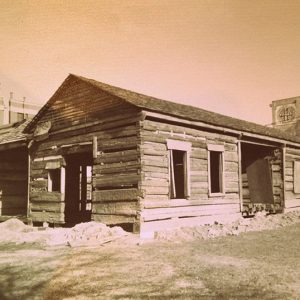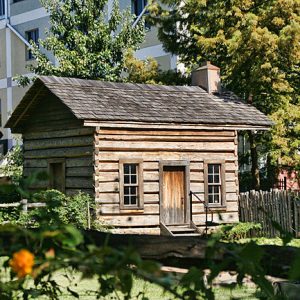calsfoundation@cals.org
Plum Bayou Log House
The Plum Bayou Log House is a unique structure placed in the heart of downtown Little Rock (Pulaski County). Originally located in Plum Bayou, a farming community in Scott (Pulaski and Lonoke counties) about ten miles southeast of Little Rock, this 1850s farmstead was moved to the grounds of what is now Historic Arkansas Museum in 1976. The cabin serves as an example of nineteenth-century farm life in rural Arkansas. The one-story cabin is composed of two units separated by a covered central hall or “dog trot,” a common architectural style. The structure is made from hewn cypress logs, and a two-room detached kitchen is connected to the house in an ell fashion.
William Stith Pemberton was born on December 27, 1823. He visited Arkansas in 1856 or 1857 to purchase property and arrange for a home to be built. Pemberton traveled in a “private conveyance with his family, negroes, household goods, etc.” and made the trip from Fayetteville, North Carolina, to Arkansas in six weeks. Much to their dismay, when the Pembertons arrived in Scott, instead of a newly built plantation house, they found only an “old double log cabin with a dead hog under it.” Laura Pemberton Robinson, daughter of William Pemberton, recalled that the family did not live in the cabin because it was deemed unhealthy, so they all “lived in tents until the old log cabin could be thoroughly cleaned and made habitable.”
Tax records for Pulaski County document W. S. Pemberton’s 1857 possessions and their respective values: twenty-three enslaved individuals ($14,950), one pleasure carriage ($100), four mules and four horses ($400), a gold watch and jewelry ($100), and two cows. During the Civil War, the women of the Pemberton family were sent back to North Carolina while William and his son remained in Arkansas to protect their property. Among the twenty-three enslaved individuals owned by William Pemberton were John Perry, his wife, and their two children. After Emancipation, the Perry family elected to stay at Plum Bayou and became successful independent farmers.
After the Pembertons moved out of the house, farm workers and tenant farmers lived in the home until the 1950s. In 1976, descendants of William Pemberton gave the house to the Arkansas Territorial Restoration, now Historic Arkansas Museum, who moved the cabin to the corner of Second and Cumberland streets. In the event that the cabin fell apart during transportation, each log was individually numbered. However, it was so well constructed that each room remained perfectly intact during the move. A slave cabin, barn, smokehouse, privy, and blacksmith shop were added to complete the rural farmstead interpretation. It is now surrounded by a period-appropriate snake rail fence.
In 2016, the Pemberton log cabin and accompanying structures were officially renamed the Parker Westbrook Farmstead, in honor of Parker Westbrook, the father of modern historic preservation in Arkansas and a longtime member of the Historic Arkansas Museum Commission. In the twenty-first century, the Parker Westbrook Farmstead serves as a reminder of the state’s early architectural heritage and rural life in nineteenth-century Arkansas.
For additional information:
“Arkansas Territorial Restoration Historic District.” National Register of Historic Places registration form. On file at Arkansas Historic Preservation Program, Little Rock, Arkansas. Online at http://www.arkansaspreservation.com/National-Register-Listings/PDF/ATRHD.nr.pdf (accessed June 20, 2019).
Bennett, Swannee. “An Interpretive Narrative and Furnishings Plan for the Arkansas Territorial Restoration Historic Structures.” Historic Arkansas Museum Archive, Little Rock, Arkansas.
Historic Arkansas Museum. http://www.historicarkansas.org/ (accessed November 19, 2021).
Plum Bayou Log Cabin, Institutional History Records, Historic Arkansas Museum Archive, Little Rock, Arkansas.
Robinson, Laura Pemberton. The Robinson Family. 1917. Online at http://www.orsi.us/wp-content/uploads/2018/02/Robinson-Family-by-Laura-Pemberton-Robinson.pdf (accessed November 19, 2021).
Worthen, William B. “Louise Loughborough and Her Campaign for ‘Courage and Fineness.’” Pulaski County Historical Review 40 (Summer 1992): 26–33.
———. “Restoring the Restoration.” History News 39 (November 1984): 6–11.
Victoria Chandler
Historic Arkansas Museum
 Historic Preservation
Historic Preservation Louisiana Purchase through Early Statehood, 1803 through 1860
Louisiana Purchase through Early Statehood, 1803 through 1860 Plum Bayou House Moving
Plum Bayou House Moving  Plum Bayou Renovation
Plum Bayou Renovation  Plum Bayou Restoration
Plum Bayou Restoration  Plum Bayou Restoration
Plum Bayou Restoration 




Comments
No comments on this entry yet.